-

新人教版高中英语必修2Unit 3 The Internet-Discovering Useful Structure教案一
This unit is about the Internet, which has a great influence to our humans and our lives. During the Listening & Speaking & Talking and Reading and Thinking section, the influence in examples has been shown. Thus, use the Present Perfect Tense is appropriate. However, in order to show the justice or weaken the doer of the behavior/action, it’s better to use the Present Perfect Passive Voice than the Present Perfect Tense. Besides, having learned to use the Present Perfect Passive Voice, students can beautify their language in their writing. 1. Learn the structure of the Present Perfect Passive Voice and its functions. 2. Learn to change the sentences with the Present Perfect Passive Voice into the sentences with the Present Perfect Passive Voice. 3. Learn to write sentences with the Present Perfect Passive Voice flexibly according to the context. 1. Learn the structure of the Present Perfect Passive Voice and its functions. 2. Learn to change the sentences with the Present Perfect Passive Voice into the sentences with the Present Perfect Passive Voice. 3. Learn to write sentences with the Present Perfect Passive Voice flexibly according to the context. Step 1 Observe the following sentences, then change the sentences into passive voice.He has been selected to take part in the sports meeting.(肯定句)他已被挑选出来参加运动会。The ink has not been removed from his overcoat.(否定句)墨迹还没有从他外套上去掉。

新人教版高中英语必修2Unit 4 History and Traditions-Discovering Useful Structure教案一
Step 5 Practice一、完成下列句子。1. Judy and I _______________(把车停下来(park))in an underground car Park near Trafalgar Square, where we could ______________________(让我们的车充电(charge)).2. When we finally reached the service desk to ask for audio guides, we heard it ___________ that there were no audio guides____________(留下,剩下).3. We__________________________(发现自己对...很惊讶)the large number of visitors and the amount of noise at the entrance of the National Gallery.4. Judy ____________________(眼神专注于) Van Gogh’s Sunflowers. It was hard to approach the painting as there were so many people around.5. She ____________________(把这幅画的复制品装箱(box)) to ensure that it was delivered safely.答案:1.had our car parked get our car battery charged 2. announced left 3. found ourselves very surprised 4. had her eyes fixed on 5. had a copy of the painting boxed二、用过去分词对下列句子进行改写。1. Loch Ness was surrounded by beautiful natural landscape, which made it look amazing.2. Carl and his friend stayed with a generous family who offered them bread with butter and honey that was homemade.3. The family’s ancestors once attended to soldiers who were wounded in the First World War.4. The young people were attracted by the legend of Loch Ness. They watched over the lake with their cameras and binoculars, which were positioned on the hill.答案:1. Loch Ness surrounded by beautiful natural landscape looks amazing.2. Carl and his friends stayed with a generous family who offered them homemade bread with butter and honey.3. The family’s ancestors once attended to wounded soldiers in the First World War.4. The young people attracted by the legend of Loch Ness watched over the lake with their cameras and binoculars positioned on the hill.

新人教版高中英语必修2Unit 4 History and Traditions-Listening&Speaking&Talking教案一
This unit is about history and traditions. From the opening page, we can know that this unit will introduce the history and traditions around the world. As Marcus Garvey says “A people without the knowledge of their past history, origin and culture is like a tree without roots”, it is important for students to realize the importance and value of knowing the history and traditions and their further meanings. And this part ( listening and speaking ) is divided into two parts: Part A---share views on historic sites, Part B ---talk about a visit to a historic tourist destination. By talking with a foreigner, the speakers introduce the historic attractions and their cultures. Part A is that William, a British student, who was going to visit the Confucius Temple and a Chinese student, Xiao Kong, who was going to the Confucius Temple to meet with the members of the research group, went together and exchanged their views on the Confucius Temple, Confucius, Confucius' descendants and Confucius' educational thoughts. Part B is a conversation between Xiao Yan, a youth hostel receptionist and Paul, a backpacker about the feelings and experience after visiting the Chinese famous tourist attraction Pingyao.1. Guide students to understand the content of listening texts in terms of the whole and key details; 2. Cultivate students' ability to guess the meaning of words in listening; discuss with their peers how to talk about historic spots and great person.3. Instruct students to use functional sentences of showing one’s excitement, surprise and disappointment.1. Guide students to understand the content of listening texts in terms of the whole and key details; 2. Cultivate students' ability to discuss with their peers the related topics.3. Enable students to use the functional items of showing one’s excitement, surprise and disappointment.

新人教版高中英语必修2Unit 3 The Internet-Reading For Writing教案一
⑦identity theft 身份盗窃⑧chat room 聊天室⑨draft your blog post 起草博客帖子⑩post embarrassing photos 张贴尴尬照片 【话题句式】 1. How do you stay safe online and avoid bad experiences on the Internet? 你如何在网上保持安全, 避免在网上的不良经历? 2. I’m not an expert, but many years as a blogger have taught me a thing or two. 我不是专家, 但作为一个博主, 我已经学了好几年了。 3. If you see or read something that makes you feel uncomfortable, leave the site immediately. 如果你看到或读到一些让你觉得不舒服的东西, 立即离开这个网站。4. Don’t give out your address or phone number. 别告诉别人你的地址或电话号码。 5. Identity theft is a common and serious problem. 身份盗窃是一个常见而严重的问题。6. Being online is no excuse for being rude, and you don’t want to become a target for a troll or cyberbully. 上网并不是无礼的借口, 你也不想成为发挑衅帖子的人或网络恶霸的目标。 7. Trolls often use several false names so that they can stay on a site. 发挑衅帖子的人经常使用几个假名, 这样他们就可以留在一个网站上。8. However, the more polite you are, the less likely it is you will be attacked. 然而, 你越有礼貌, 你被攻击的可能性就越小。

新人教版高中英语必修2Unit 5 Music-Discovering Useful Structures教案一
Step1:自主探究。1.(教材P52)Born(bear) in the USA on 2 January 1970, Whitacre began studying music at the University of Nevada in 1988.2.(教材P52) Moved(move) by this music, he said, “It was like seeing color for the first time.”3.(教材P56)I was very afraid and I felt so alone and discouraged(discourage).4.(教材P58)Encouraged(encourage) by this first performance and the positive reaction of the audience, I have continued to play the piano and enjoy it more every day.Step2:语法要点精析。用法1:过去分词作表语1).过去分词可放在连系动词be, get, feel, remain, seem, look, become等之后作表语,表示主语所处的状态Tom was astonished to see a snake moving across the floor.汤姆很惊讶地看到一条蛇正爬过地板。Finally the baby felt tired of playing with those toys.终于婴儿厌倦了玩那些玩具。注意:1).过去分词作表语时与被动语态的区别过去分词作表语时,强调主语所处的状态;而动词的被动语态表示主语是动作的承受者,强调动作。The library is now closed.(状态)图书馆现在关闭了。The cup was broken by my little sister yesterday.(动作)昨天我妹妹把杯子打碎了。2)感觉类及物动词的现在分词与过去分词作表语的区别过去分词作表语多表示人自身的感受或事物自身的状态,常译作“感到……的”;现在分词多表示事物具有的特性,常译作“令人……的”。
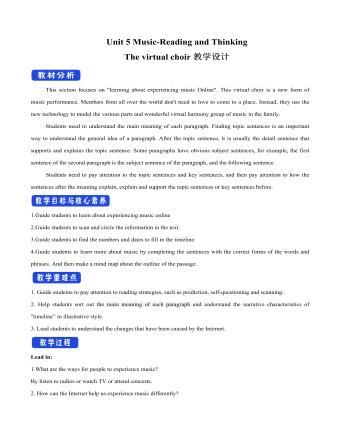
新人教版高中英语必修2Unit 5 Music-Reading and Thinking教案一
This section focuses on "learning about experiencing music Online". This virtual choir is a new form of music performance. Members from all over the world don't need to love to come to a place. Instead, they use the new technology to model the various parts and wonderful virtual harmony group of music in the family. Students need to understand the main meaning of each paragraph. Finding topic sentences is an important way to understand the general idea of a paragraph. After the topic sentence, it is usually the detail sentence that supports and explains the topic sentence. Some paragraphs have obvious subject sentences, for example, the first sentence of the second paragraph is the subject sentence of the paragraph, and the following sentenceStudents need to pay attention to the topic sentences and key sentences, and then pay attention to how the sentences after the meaning explain, explain and support the topic sentences or key sentences before.1.Guide students to learn about experiencing music online2.Guide students to scan and circle the information in the text.3.Guide students to find the numbers and dates to fill in the timeline.4.Guide students to learn more about music by completing the sentences with the correct forms of the words and phrases. And then make a mind map about the outline of the passage.1. Guide students to pay attention to reading strategies, such as prediction, self-questioning and scanning.2. Help students sort out the main meaning of each paragraph and understand the narrative characteristics of "timeline” in illustrative style.3. Lead students to understand the changes that have been caused by the Internet.
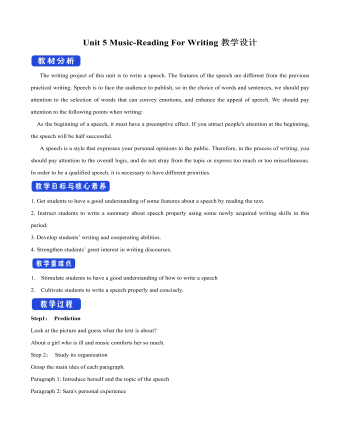
新人教版高中英语必修2Unit 5 Music-Reading For Writing教案一
(4)Now we have heard a number of outstanding speeches ... 我们已经聆听了许多精彩的发言……(5)Because we wanted the nations of the world, working together, to deal with ... 因为我们希望全世界各国团结起来去应对……(6)And if we do not act ... 如果我们不采取行动……(7)Now, I share the concerns that have been expressed ... 我也同意对于……表达的担心(8)Let us show the world that by working together we can ... 让我们告诉全世界,通过一起努力我们可以……(9)It is now time for us to ... 是时候我们……(10)And I have always wished that ... 我一直希望……(11)Thank you for letting me share this day with me.感谢你们和我共度这一天。实践演练:假如你是高中生李华,你校将举办一次以“音乐”为主题的演讲比赛,请你按照主题,写下你的演讲稿。注意:词数100左右。First of all, thank you for listening to my speech. My topic is: love music like love yourself.Music is like the air we need to maintain our normal lives around us. You can't imagine how terrible a world without music would be. Movies and TV shows have no music, only dry conversations and scenes; mobile phones only vibrations; streets only noisy crowds; cafes, western restaurants only depressed meals. What a terrible world it is!As a student, I hope we all can enjoy the fun brought by music in our spare time. Instead of just listening to music, we can even make our own music. Let's enjoy the fun of music!Thanks again for your attention!

新人教版高中英语必修3Unit 2 Morals and virtues教学设计一
(2) students are divided into groups according to the requirements of activity 3. Each student shares a story of personal experience or hearing-witnessing kindness, and then selects the most touching story in the group and shares it with the whole class. Before the students share the story, the teacher can instruct them to use the words and sentence patterns in the box to express. For example, the words in the box can be classified:Time order: first of all, then, after that, later, finally logical relationship :so, however, although, butTeachers can also appropriately add some transitional language to enrich students' expression:Afterwards, afterwards, at last, in the end, eventuallySpatial order: next to, far from, on the left, in front ofOtherwise, nevertheless, as a result, therefore, furthermore, in addition, as well asSummary: in a word, in short, on the whole, to sum up, in briefStep 8 Homework1. Understand the definition of "moral dilemma" and establish a correct moral view;2. Accumulate vocabulary about attitudes and emotions in listening texts and use them to express your own views;3. Complete relevant exercises in the guide plan.1、通过本节内容学习,学生能否理解理解“道德困境”的定义;2、通过本节内容学习,学生能否通过说话人所表达的内容、说话的语气、语调等来判断其态度和情绪;3、通过本节内容学习,学生能否针对具体的道德困境发表自己的看法和见解,能否掌握听力理训练中的听力策略。
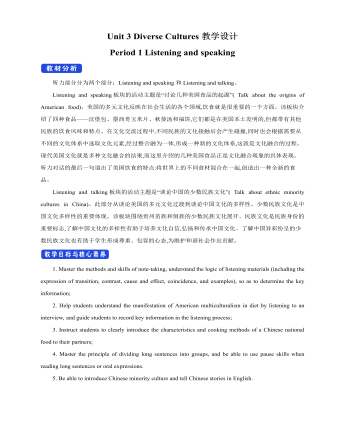
新人教版高中英语必修3Unit 3 Diverse Cultures教学设计一
Activity 81.Grasp the main idea of the listening.Listen to the tape and answer the following questions:Who are the two speakers in the listening? What is their relationship?What is the main idea of the first part of the listening? How about the second part?2.Complete the passage.Ask the students to quickly review the summaries of the two listening materials in activity 2. Then play the recording for the second time.Ask them to complete the passage and fill in the blanks.3.Play the recording again and ask the students to use the structure diagram to comb the information structure in the listening.(While listening, take notes. Capture key information quickly and accurately.)Step 8 Talking Activity 91.Focus on the listening text.Listen to the students and listen to the tape. Let them understand the attitudes of Wu Yue and Justin in the conversation.How does Wu Yue feel about Chinese minority cultures?What does Justin think of the Miao and Dong cultures?How do you know that?2.learn functional items that express concerns.Ask students to focus on the expressions listed in activity. 3.And try to analyze the meaning they convey, including praise (Super!).Agree (Exactly!)"(You're kidding.!)Tell me more about it. Tell me more about it.For example, "Yeah Sure." "Definitely!" "Certainly!" "No kidding!" "No wonder!" and so on.4.Ask the students to have conversations in small groups, acting as Jsim and his friends.Justin shares his travels in Guizhou with friends and his thoughts;Justin's friends should give appropriate feedback, express their interest in relevant information, and ask for information when necessary.In order to enrich the dialogue, teachers can expand and supplement the introduction of Miao, dong, Lusheng and Dong Dage.After the group practice, the teacher can choose several groups of students to show, and let the rest of the students listen carefully, after listening to the best performance of the group, and give at least two reasons.
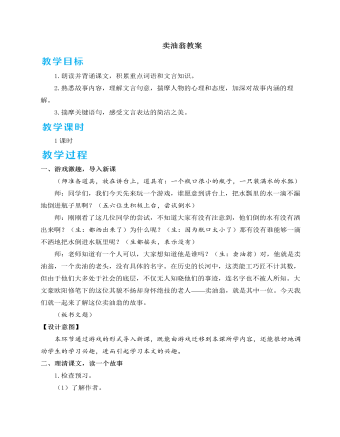
人教部编版七年级下册卖油翁教案
本篇故事虽短,但记述简洁生动,情趣盎然,人物形象鲜明,哲理深入浅出,是学生了解传统文化,学习浅易文言文,增强文言语感的经典文言小品文。所以本教学设计首先注重落实字词基础;然后用抢答的方式帮助学生理解课文内容;再以人物为核心,细读课文,通过表演的方式,抓住重点实词、虚词,揣摩人物的心理和个性特点,了解文言语言简洁精练的特点,激发学生学习文言文的兴趣。通过质疑探究,走进文本背后,引导学生学习探究文言故事的方法,培养学生独立思考、质疑探究的能力。文学知识笔记体小说笔记体小说指具有小说性质,介于随笔和小说之间的一种文体,是中国古典小说的一种。笔记体小说多以人物趣闻逸事、民间故事传说为题材,具有写人粗疏、叙事简约、篇幅短小,形式灵活、不拘一格的特点。笔记体小说的起源可以追溯到南朝刘义庆的《世说新语》。代表作有清代纪昀的《阅微草堂笔记》等。
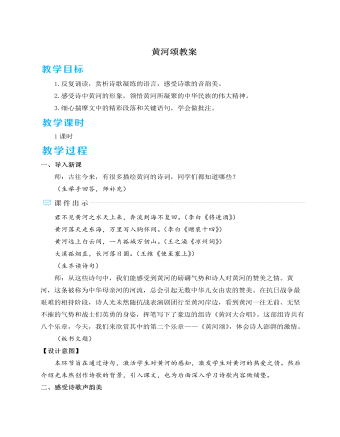
人教部编版七年级下册黄河颂教案
资料链接1.《黄河大合唱》《黄河大合唱》是由光未然作词、冼星海谱曲的一部大型合唱音乐作品,有《黄河船夫曲》《黄河颂》《黄河之水天上来》《黄水谣》《河边对口曲》《黄河怨》《保卫黄河》《怒吼吧,黄河!》八个乐章。诗中将雄奇的想象与现实的图景结合在一起,组成了一幅幅壮阔的历史画卷。2.中华民族精神中华民族在悠久的发展历史中,积淀和形成了自己独特而伟大的民族性格和民族精神。中华文化的基本精神,表现了自强不息、居安思危、厚德载物、乐天知足、崇尚礼仪等特征。中华文化的力量,集中体现为民族精神的力量。中华民族精神的核心是爱国主义。这种精神就像是泰山、长城一般壮丽地雄峙于世界的东方!疑难探究如何把握《黄河颂》语言上的特点?这首歌词写得明快雄健,节奏鲜明,音节洪亮。以短句为主,兼以长句;长短结合,自由奔放并且错落整齐。在韵脚上,隔二三句押韵,形成了自然和谐的韵律。

人教部编版七年级下册老山界教案
【设计意图】本环节既总结了学习的内容,也拓展了文章的主题;引导学生理解长征精神在当今时代的作用、意义,并传承长征精神,接受革命传统教育。四、总结存储1.教师总结。文章在叙述红军翻越老山界的经过中,进行了富有抒情气息的描写,展现了红军伟大的精神力量,也让我们感受到了长征岁月中浪漫的英雄情怀。岁月沧桑,斗转星移,中国已发生翻天覆地的变化,长征精神亦成为中华民族的宝贵精神财富。年轻一代的我们,应坚定信念,弘扬长征精神,为中华民族的伟大复兴而努力,弹奏新征途的“天籁之音”。2.布置作业。(1)课外选读:《大渡河畔英雄多》(杨得志)、《越过夹金山,意外会亲人》(杨成武)。(2)以小组为单位编写一期有关长征精神的手抄报,参加班级展示活动。
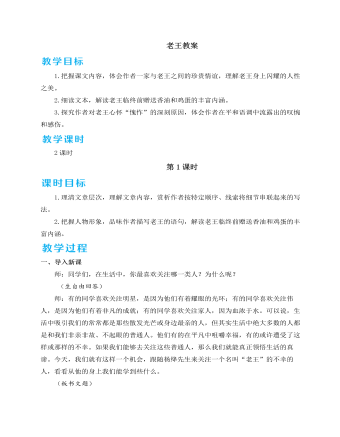
人教部编版七年级下册老王教案
素养提升作文中怎样运用“以小见大”的写作手法(1)以小人物见大。这里的“小人物”是指在社会上不出名、没有影响的人。以小人物见大,即以生活中平凡的小人物为叙写对象,通过塑造小人物的形象,揭示其闪光的品质,彰显其伟大的人格,折射出底层人民的光芒,喻人以大道理,动人以大感情,从而起到激励、感化读者的大作用。(2)以小事见大。可以通过叙写生活中极其平常的小事阐述一个大的道理。文化常识典故故事——君子之交“君子之交”语出《庄子·山木》:“且君子之交淡若水,小人之交甘若醴;君子淡以亲,小人甘以绝。”君子之交,意思是贤者之间的交情,平淡如水,不尚虚华。唐贞观年间,薛仁贵尚未得志之前,与妻子住在一个破窑洞中,衣食无着落,全靠王茂生夫妇接济。后来,薛仁贵参军,在跟随唐太宗李世民御驾东征时,立下汗马功劳,被封为“平阳郡公”。一登龙门,身价百倍,前来送礼祝贺的文武大臣络绎不绝,可都被薛仁贵婉言谢绝了。
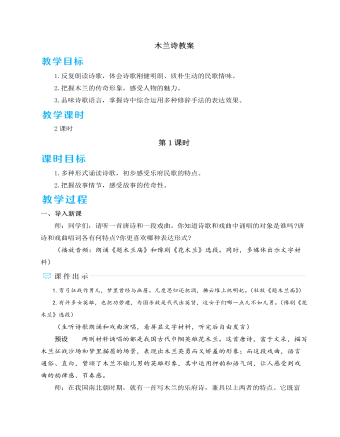
人教部编版七年级下册木兰诗教案
本教学设计着眼于民歌特点。第1课时重在诵读诗歌,设计不同层次的读,引导学生从诗歌的形式、节奏、韵律、情感四个方面感受民歌形式自由、具有韵律美、节奏感强、情感富于变化的特点,从而体会民歌的情味。第2课时重在品读诗歌,引导学生通过品析情节、品味语言、析读主题等方式,体会诗歌语言刚健明朗而质朴生动的特点,逐层解读民歌所塑造的传奇形象,并理解民歌所传达的爱国情怀。素养提升互 文互文,也叫互辞,是古诗文中常用的一种修辞手法。古文中对它的解释是:“参互成文,合而见义。”具体地说,它是这样一种表现形式:上下两句或一句话中的两个部分,看似各说两件事,实则是互相呼应,互相阐发,互相补充,说的是一件事。即上下文义互相交错、互相渗透、互相补充地来表达一个完整的意思。初中阶段,常见的互文一般有三类:(1)单句互文单句互文,即在同一个句子中前后两个词语在意义上相互交错、渗透、补充。如:秦时明月汉时关。
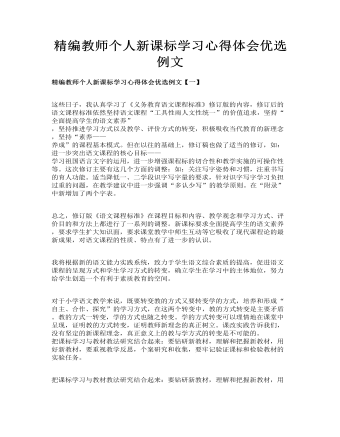
精编教师个人新课标学习心得体会优选例文
我将根据新的语文能力实践系统,致力于学生语文综合素质的提高,促进语文课程的呈现方式和学生学习方式的转变,确立学生在学习中的主体地位,努力给学生创造一个有利于素质教育的空间。 对于小学语文教学来说,既要转变教的方式又要转变学的方式,培养和形成“自主、合作、探究”的学习方式,在这两个转变中,教的方式转变是主要矛盾。教的方式一转变,学的方式也随之转变。学的方式转变可以理情地在课堂中呈现,证明教的方式转变,证明教师新理念的真正树立。课改实践告诉我们,没有坚定的新课程理念,真正意义上的教与学方式的转变是不可能的。把课标学习与教材教法研究结合起来:要钻研新教材,理解和把握新教材,用好新教材,要重视教学反思,个案研究和收集,要牢记验证课标和检验教材的实验任务。
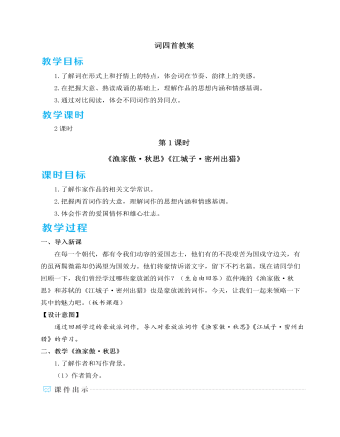
人教部编版语文九年级下册词四首教案
词人如此有违常规,造成了一种拗峭不凡的气势,词意更加纵横驰骋,抒情更加酣畅淋漓。2.如何理解《满江红》(小住京华)中的“俗子”?从这首词的语境来看,“俗子”当指词人的丈夫。这与“八年风味”的婚姻反思,与“青衫湿”的悲情是前后呼应的。秋瑾在后来写的一首《沁园春》中说:“有多少,遇王郎天壤,辜负才华。”在长篇弹词《精卫石》中说:“道韫文章男不及,偏遇个天壤王郎冤不冤。”这些词句,都是借谢道韫所嫁非人,间接抒发了她对婚姻的失望。王郎天壤(天壤王郎),是谢道韫鄙薄她丈夫王凝之的话,出自《世说新语·贤媛》:“一门叔父,则有阿大、中郎;群从兄弟,则有封、胡、遏、末,不意天壤之中,乃有王郎!”当然,从广义上理解,这首词中的“俗人”,也可泛指世俗之人。秋瑾到日本后写的《鹧鸪天》词中,有“祖国沉沦感不禁,闲来海外觅知音”的词句,可见“觅知音”意指寻求救国之道,不一定指个人的情感问题。
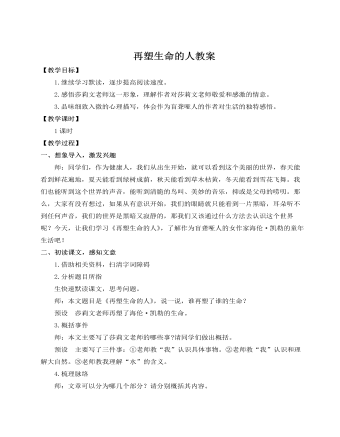
人教部编版七年级语文上册再塑生命的人教案
海伦·凯勒一岁多时不幸染上疾病,致使她双目失明、双耳失聪,随之又丧失了说话的能力。从此,她坠入了一个黑暗而沉寂的世界,陷入了痛苦的深渊。17岁,海伦·凯勒考进哈佛大学,还掌握了英、法、德、拉丁和希腊五种语言。大学期间,她开始写作。毕业后,她把自己的一生献给了盲人福利和教育事业,并在繁忙的工作中先后完成了14部具有世界影响的著作,最著名的是其自传《假如给我三天光明》。海伦·凯勒无比敬爱和感激自己的老师莎莉文,她说:“假如给我三天光明,我首先要长久地凝视我的老师——安妮·莎莉文!”海伦把自己的学习分成四个步骤:1.每天用三个小时自学。2.用两个小时默记所学的知识。3.再用一个小时的时间将自己用三个小时所学的知识默写下来。4.剩下的时间她运用学过的知识练习写作。在学习与记忆的过程中,她只有一个信念:她一定能够把自己所学习的知识记下来,使自己成为一个有用的人。她每天坚持学习10个小时以上,经过长时间的刻苦学习,她掌握了大量的知识,能熟练地背诵大量的诗词和名著的精彩片段。
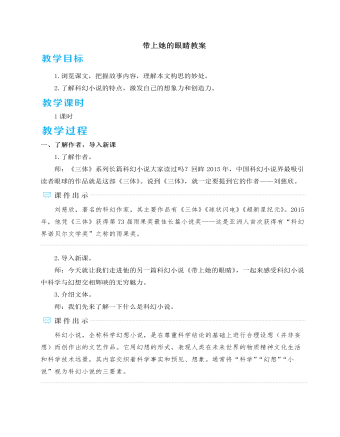
人教部编版七年级下册带上她的眼睛教案
在人物方面,刘慈欣的小说继承了古典科幻小说中的人物塑造规律,即无论是技术专家还是普通人,他们一定要在社会的变革中被推向改变世界的精英舞台。在情感线索方面,刘慈欣与其他新生代作家的主要区别是,他很少将男女关系置于情感的中心位置(虽然他的男女情感写得细腻而成熟)……在他的作品中,科学的诗意永远是一种基本情调。疑难探究如何理解小说中的“我”和小姑娘这两个人物形象?小说的主要人物是“我”与“她”(小姑娘)。“我”是小说的叙事者,也是小说中“行动着”的人,起着串联情节的作用。“我”的性格既有开朗热情的一面,也有灰色伤感的另一面,内心深处的悲悯情怀,使“我”这个形象更加丰满。小姑娘作为地航飞船的领航员,身处险境而不惊恐,不慌乱,还不告诉“我”自己所处的位置,不倾诉自己的郁闷,以大无畏的精神继续坚守岗位,不仅表现出勇敢、乐观、坚韧的品质,更带有一种悲壮的英雄主义色彩。
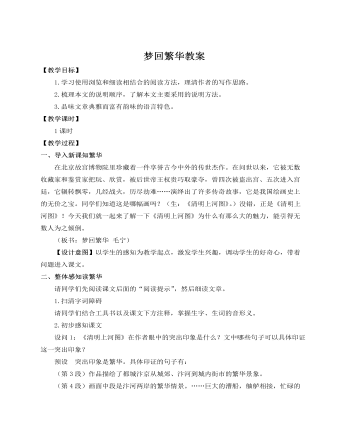
人教部编版语文八年级上册梦回繁华教案
设问2:第3段和第4段都写繁华,两段的区别是什么?预设 第3段是概括总写繁华景象,第4段则是具体描绘繁华景象。两段之间是从概括到具体的逻辑关系。【设计意图】通过细读课文,让学生在把握生字词的基础上对课文有初步的感知,可以用简单的词语概括作者所感知画面的整体特点,而且能够用文中具体的语句加以印证。以此训练学生自主把握文章重要信息的能力。三、自主探究寻繁华1.浏览课文,理清全文的说明顺序设问1:作者介绍了这幅画哪些方面的信息?在文中进行勾画批注,并说说文章可分为哪几个部分,概括主要意思。(生浏览勾画,批注交流)预设 文章分为三个部分:第1段:介绍这幅画作的创作背景,引出本文的说明对象——《清明上河图》。第2段:介绍了这幅画作的作者张择端及其创作动机。
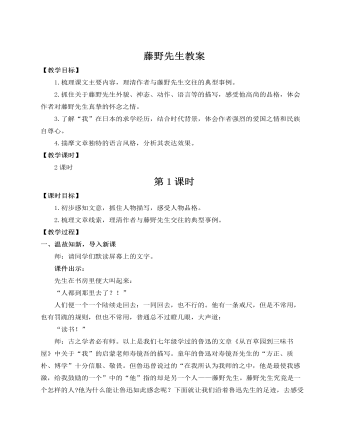
人教部编版语文八年级上册藤野先生教案
预设 清政府派遣这些留学生去国外留学,目的是学习国外先进的科学技术,回来报效国家,然而实际上他们在国外不学无术,忘记了自身使命和肩上的责任。作者在描写完留学生的这些丑态之后,采用了反语的手法,用一句话进行了总结——“实在标致极了”,仿佛是压抑不住的火山爆发,极尽讽刺之能事,酣发鄙夷、憎恶之胸臆。师:作者在这里采用了反语的手法,暗讽“清国留学生”们的丑态,除此之外,文中还有哪些地方运用了这种手法?预设 作者称日俄战争时的日本学生为“爱国青年”,说自己国内的论敌为“正人君子”,都是运用反语进行嘲讽。又如说日本对医学的翻译“并不比中国早”,说日本青年虽抗议托尔斯泰引用《新约》中的话,但他们“暗地里却早受了他的影响了”,都是话里有话,含义无穷的。【设计意图】此环节通过“咬文嚼字”,让学生学会从字里行间来品析文章深意,同时使学生进一步揣摩鲁迅先生“幽默讽刺、含蓄深蕴”的语言风格。









